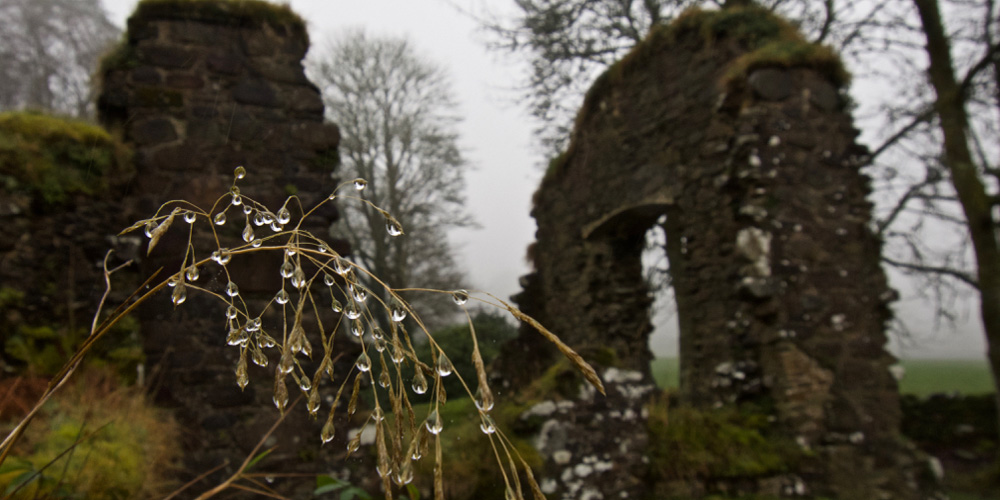
Saddell Abbey – in the footsteps of Somerled
When you have your birthday in early January and you fancy a day out, you have to put up with whatever the weather throws at you.
With the forecast promising sunshine a few days beforehand, I took a look at the map and thought that a drive to Saddell Abbey might be nice. Lovely sea views on the way down, with the chance of wildlife.
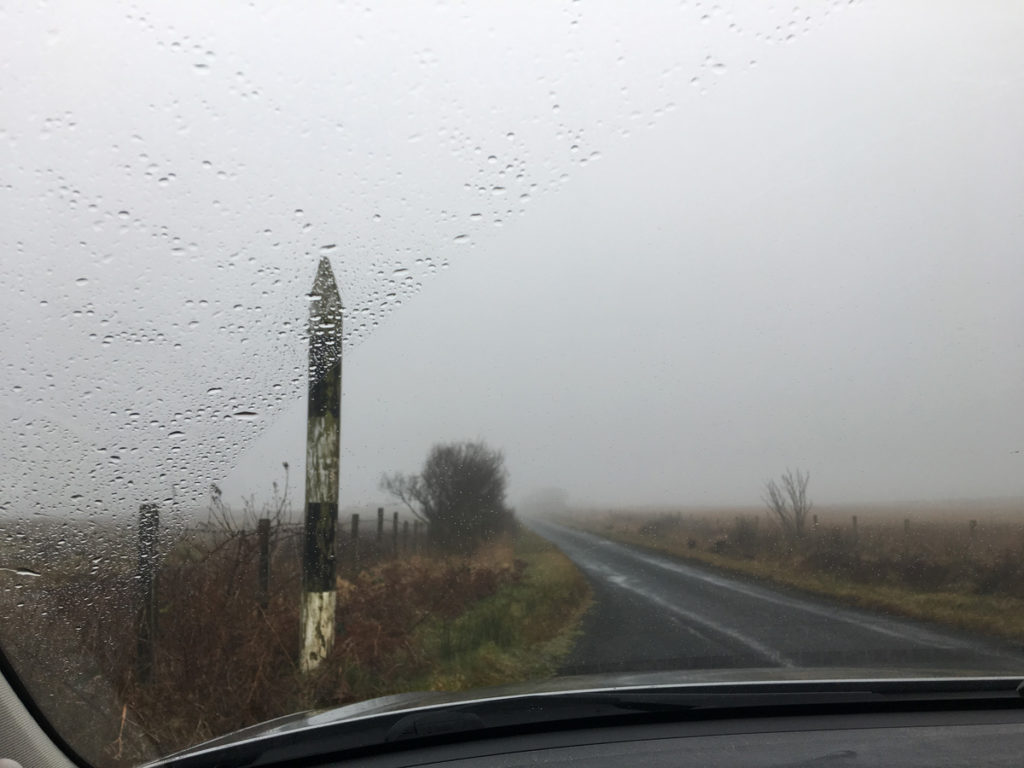
The views on Sunday morning, however, were rather less than crystal-clear. As we drove down to Lochgilphead and then headed further south towards Tarbert the mist gave way to fog, which was accompanied by soft rain. Daylight was questionable. Everything was shrouded in grey, with no distinct boundary between sea and sky. Nor were there many signs of life: hardly anyone was out and about around the scattered cottages and farmhouses. Along the winding coast road we met only a handful of cars, all with their lights on. By the time we’d passed Carradale we had broken into our packed lunch out of desperation, and were laughing about Paul McCartney’s ‘Mull of Kintyre’.
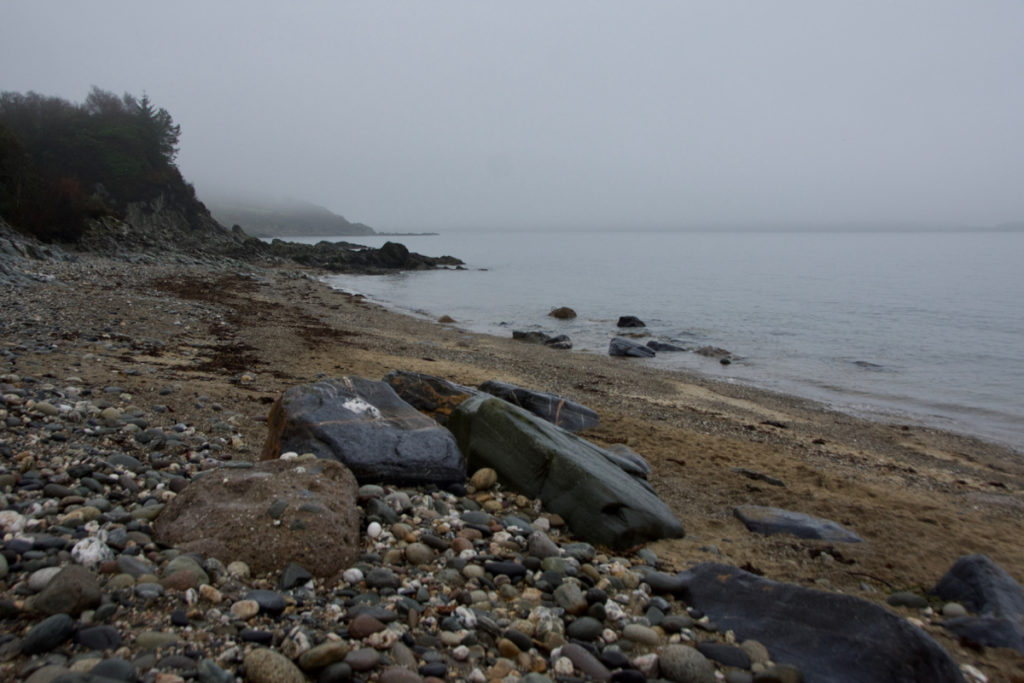 With the mist still rolling in from the sea, we stopped in a layby to take a brief wander on a pebbly beach. Three grey seals put their heads up and watched us curiously. The pebbles were pretty – hues of bright orange and pink, probably carnelian, mixed with basalt and granite. Then we pressed on, round another couple of hairpin bends, until a signpost directed us to the car park at Saddell Abbey.
With the mist still rolling in from the sea, we stopped in a layby to take a brief wander on a pebbly beach. Three grey seals put their heads up and watched us curiously. The pebbles were pretty – hues of bright orange and pink, probably carnelian, mixed with basalt and granite. Then we pressed on, round another couple of hairpin bends, until a signpost directed us to the car park at Saddell Abbey.
I don’t really know what made me want to go there, and I only had a vague idea that the place was historically significant. I felt bad that I was dragging Colin around yet more ruins on the dreichest of dreich days. Optimistically, we clad ourselves in waterproofs and I made a mental note to keep my camera lens pointing downwards.
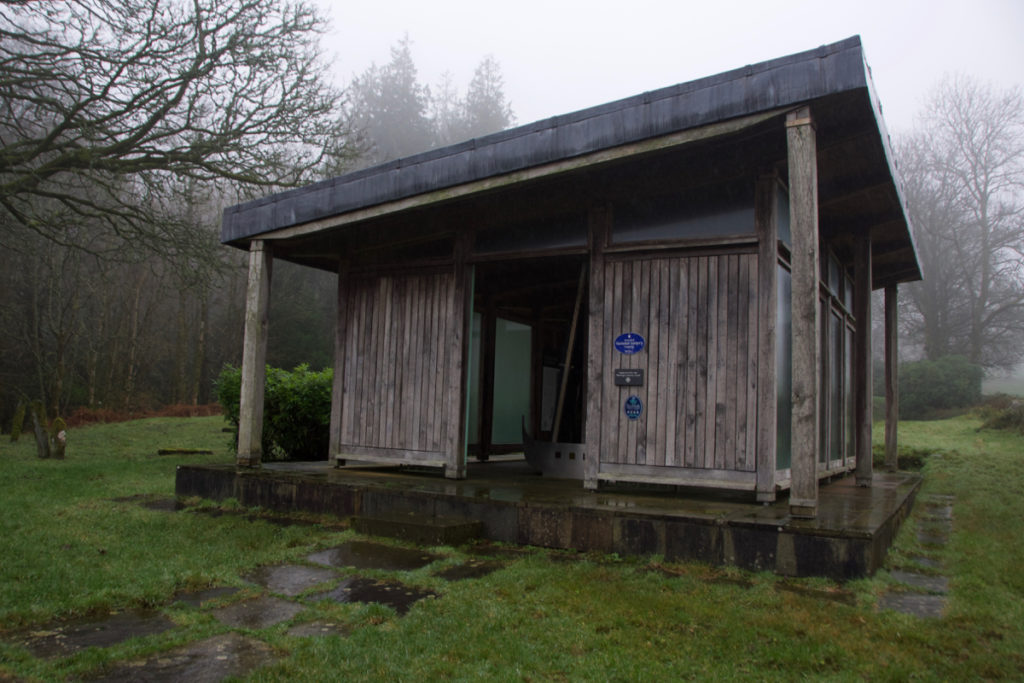 A short walk up a farm track, through a gate on the left, and a newish wooden building loomed in front of us. This, we discovered, housed a collection of medieval carved gravestones. If, by now, you’ve been reading my blog for long enough to develop a nervous tic at the mention of medieval gravestones, I’d advise you to look away now, or click onto another post, although I can’t guarantee that it will be any better. What I’ve got to say about these stones, however, is that the knight-effigies were very much life-size and more arresting than any I’ve seen to date.
A short walk up a farm track, through a gate on the left, and a newish wooden building loomed in front of us. This, we discovered, housed a collection of medieval carved gravestones. If, by now, you’ve been reading my blog for long enough to develop a nervous tic at the mention of medieval gravestones, I’d advise you to look away now, or click onto another post, although I can’t guarantee that it will be any better. What I’ve got to say about these stones, however, is that the knight-effigies were very much life-size and more arresting than any I’ve seen to date.
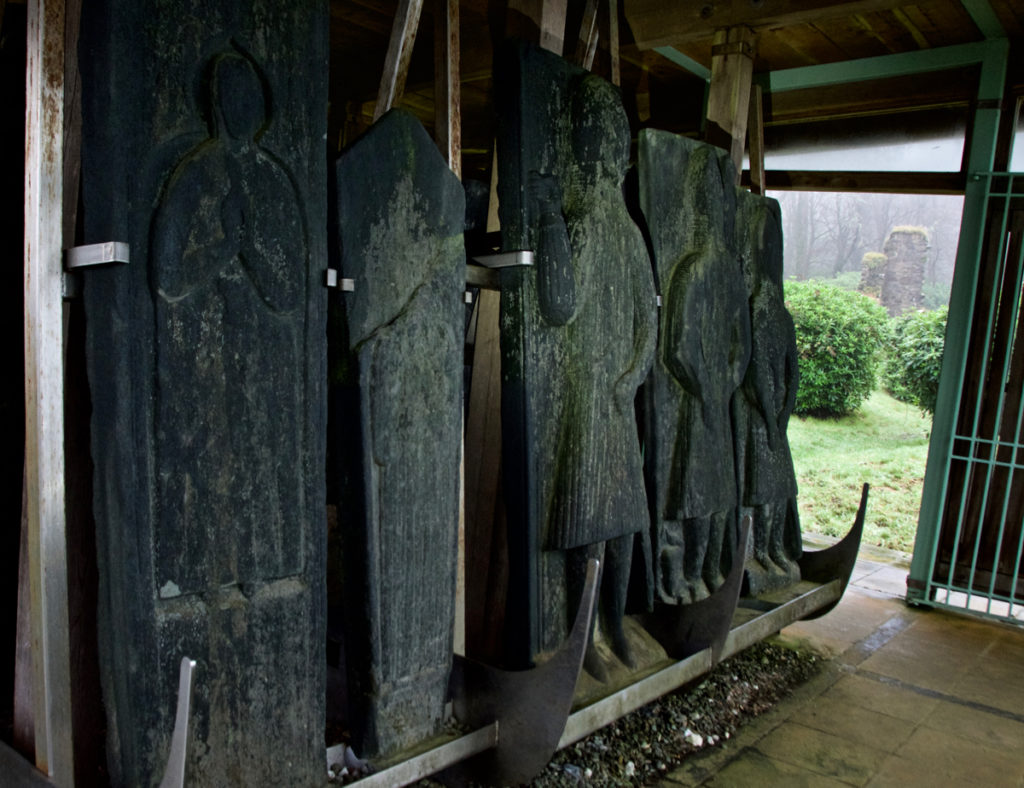 They were all lined up neatly, with the remains of what looked like a high cross in one corner. The details proved quite tricky to photograph in the dim light, but Colin found a torch in his pocket and shone it onto interesting spots. Amazing details stood out. According to an information board, the knights are wearing distinctive West Highland armour, while priests are also depicted, kneeling in prayer; other recurring themes such as birlinns (galleys) and swords reminded me of other stones in Kilmory Knap, Kilberry and Kilmartin. Echoes of the Knights Templar again here? Maybe. There never seems to be enough written evidence, but sometimes I feel the symbols hold the key, if we could interpret them correctly.
They were all lined up neatly, with the remains of what looked like a high cross in one corner. The details proved quite tricky to photograph in the dim light, but Colin found a torch in his pocket and shone it onto interesting spots. Amazing details stood out. According to an information board, the knights are wearing distinctive West Highland armour, while priests are also depicted, kneeling in prayer; other recurring themes such as birlinns (galleys) and swords reminded me of other stones in Kilmory Knap, Kilberry and Kilmartin. Echoes of the Knights Templar again here? Maybe. There never seems to be enough written evidence, but sometimes I feel the symbols hold the key, if we could interpret them correctly.
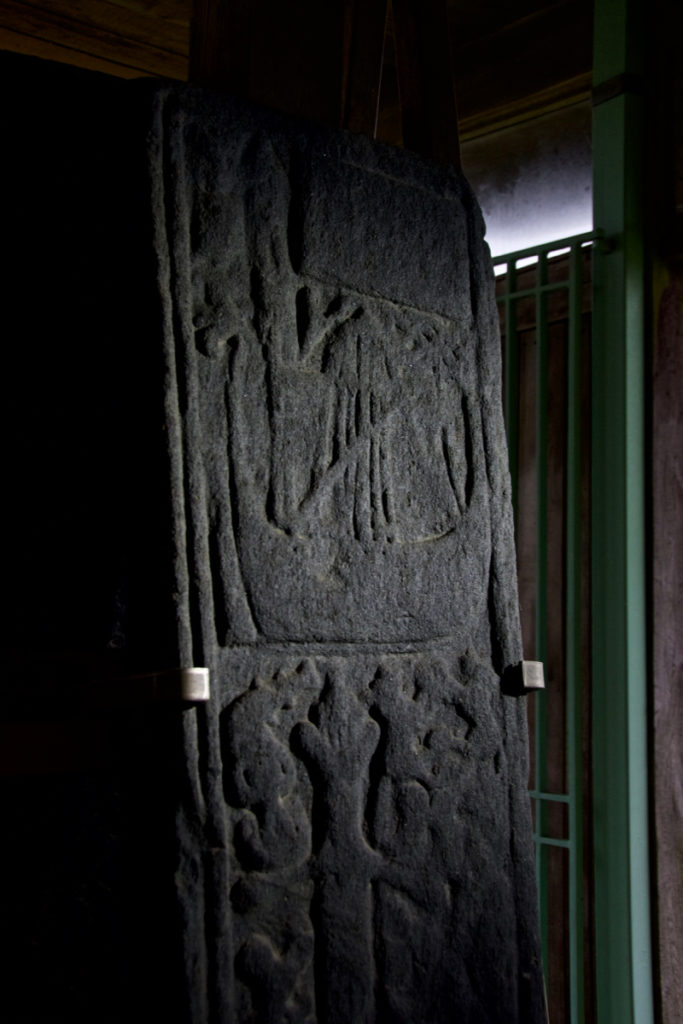
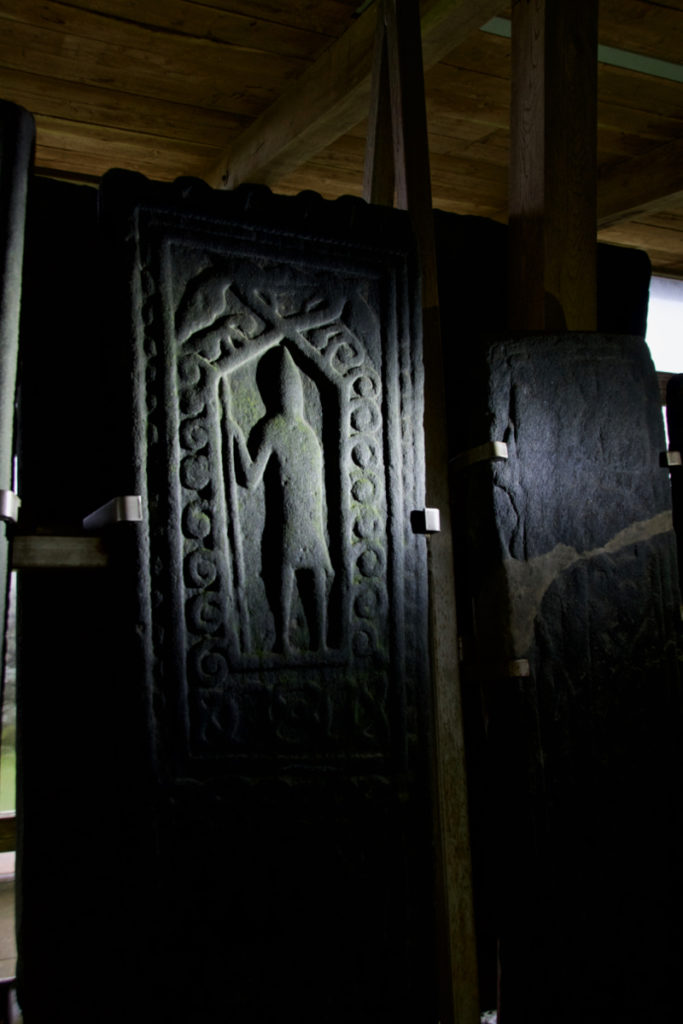
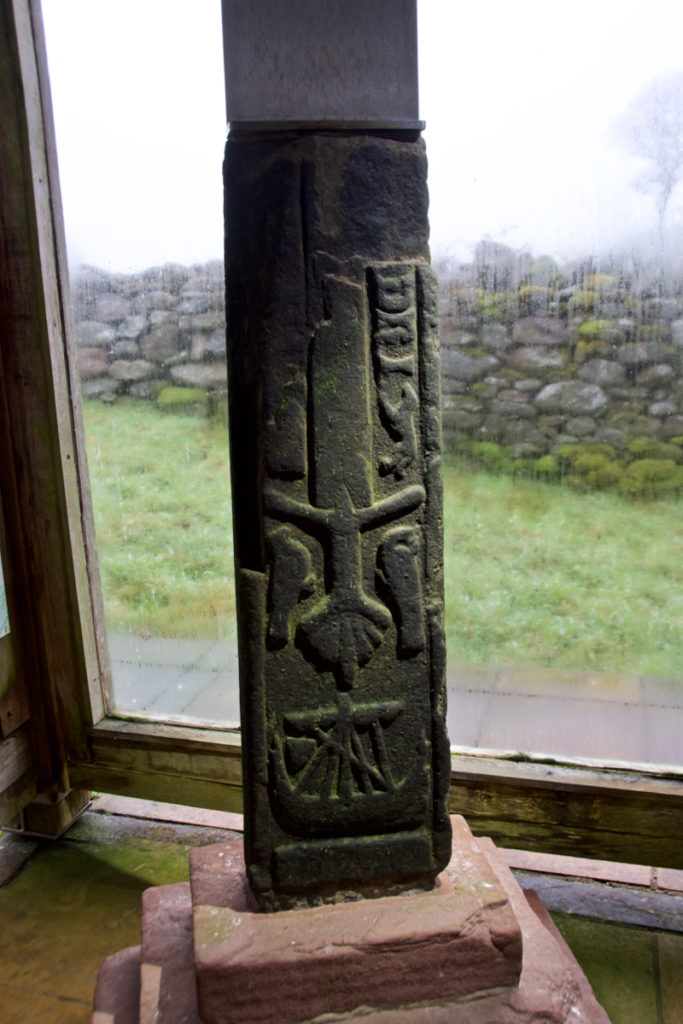
It is thought that the figures may have been painted at one time, which would certainly have stopped you in your tracks. We can put a name to one of them: the largest effigy (above), of a man well over six foot, has a Latin inscription revealing that it was commissioned by Donald MacNair, in honour of his father, Neil.
Out of the building again, and up the gently sloping ground to the graveyard of Saddell Abbey, where the ruins themselves were looming darkly out of the mist. I stopped to look at some of the headstones, many of which were illegible or completely covered with moss and lichen. Hardly surprising, with woodland close by, and a mild but damp maritime climate! The ones I could read, however, turned out to be very interesting. One particular name rooted me to the spot. I’ll tell you more later on!
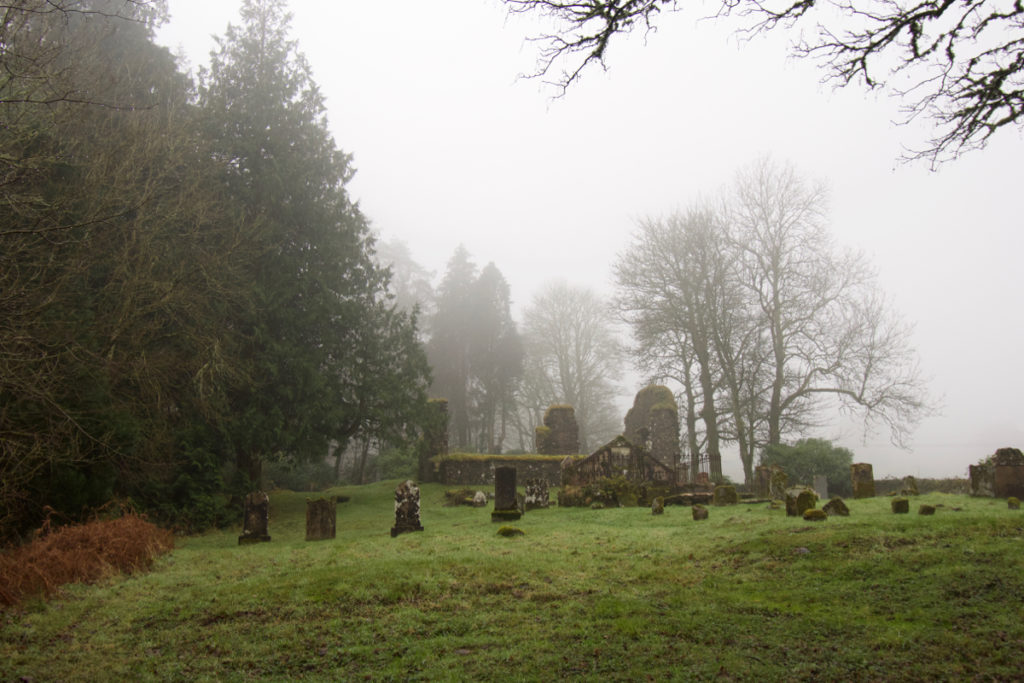 So what is there to see of Saddell Abbey? It was quite hard to make sense of it at first, because it seems that, of what was once quite a substantial building, only a few random parts remain. The abbey originally consisted of a church and three ranges of buildings around a cloister. The surviving walls represent the presbytery and the north transept of the church; a short distance away, the low walls of a room from the south range are also visible. They are just empty containers now, cold broken stone, and it’s hard to gain any sense of the atmosphere, the discipline and quiet industry that once must have pervaded this place. You can see why it was chosen, though: it is close to a stream which provided fresh water, and it is in the most serenely tranquil spot, far away from the noise of civilisation.
So what is there to see of Saddell Abbey? It was quite hard to make sense of it at first, because it seems that, of what was once quite a substantial building, only a few random parts remain. The abbey originally consisted of a church and three ranges of buildings around a cloister. The surviving walls represent the presbytery and the north transept of the church; a short distance away, the low walls of a room from the south range are also visible. They are just empty containers now, cold broken stone, and it’s hard to gain any sense of the atmosphere, the discipline and quiet industry that once must have pervaded this place. You can see why it was chosen, though: it is close to a stream which provided fresh water, and it is in the most serenely tranquil spot, far away from the noise of civilisation.
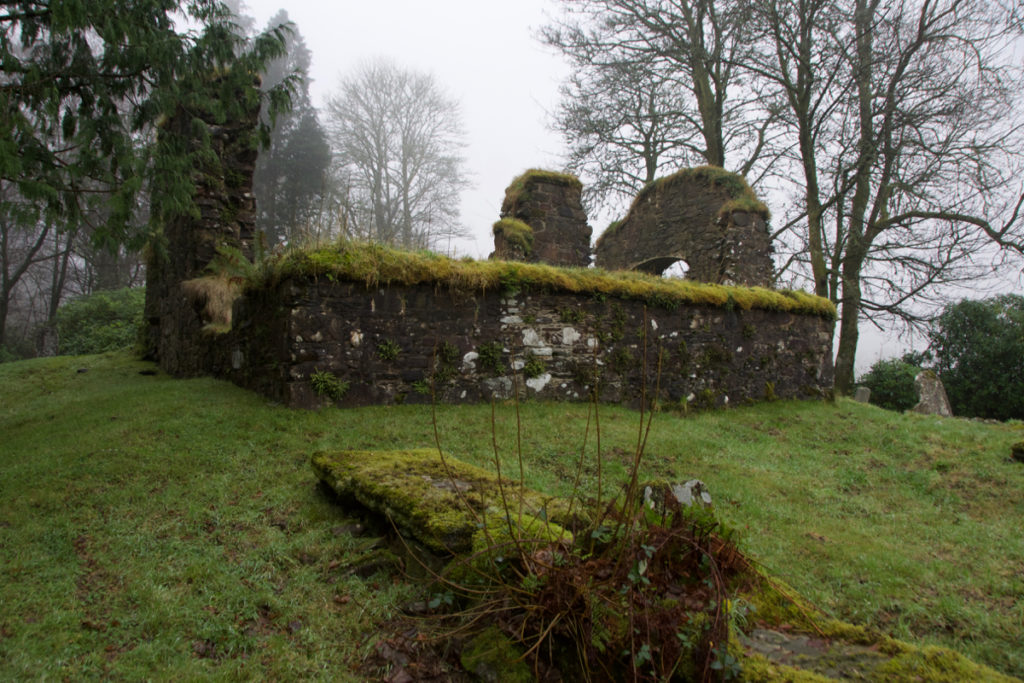
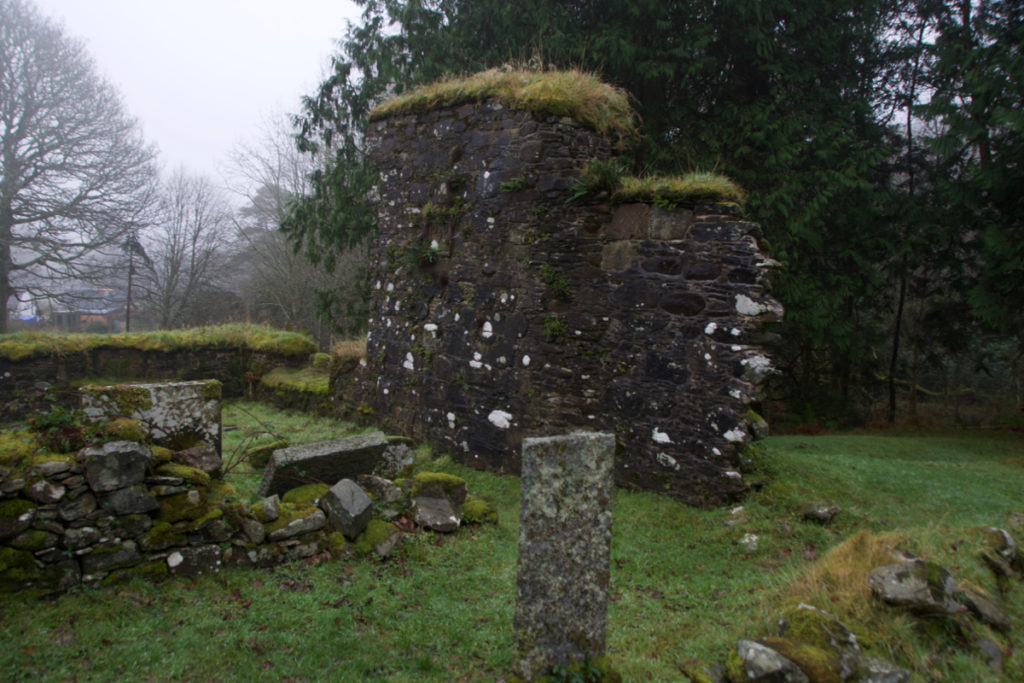
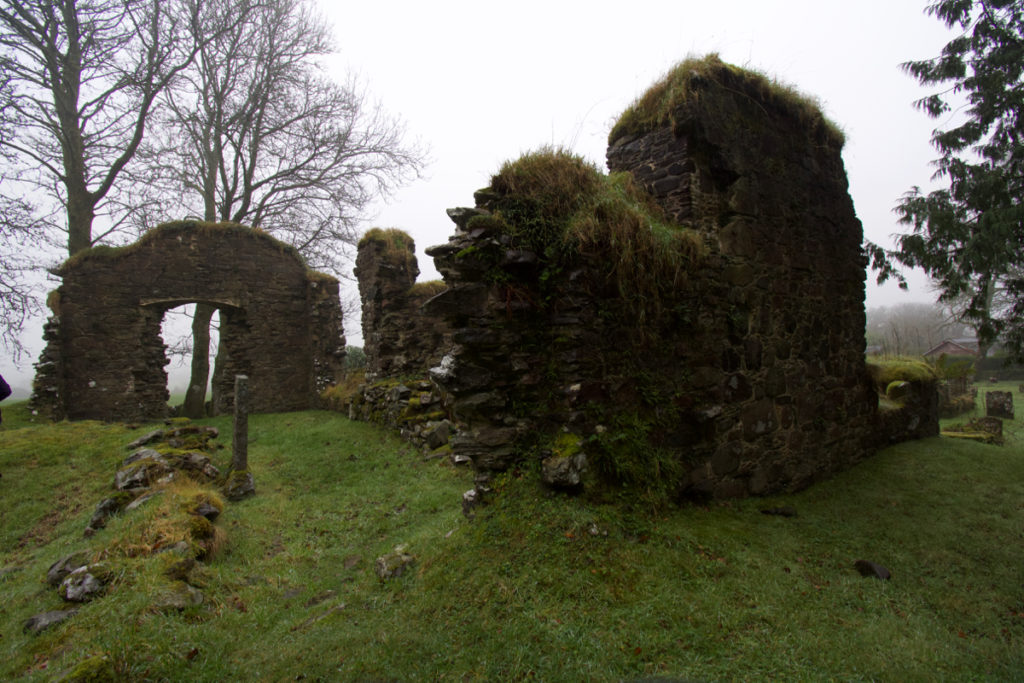
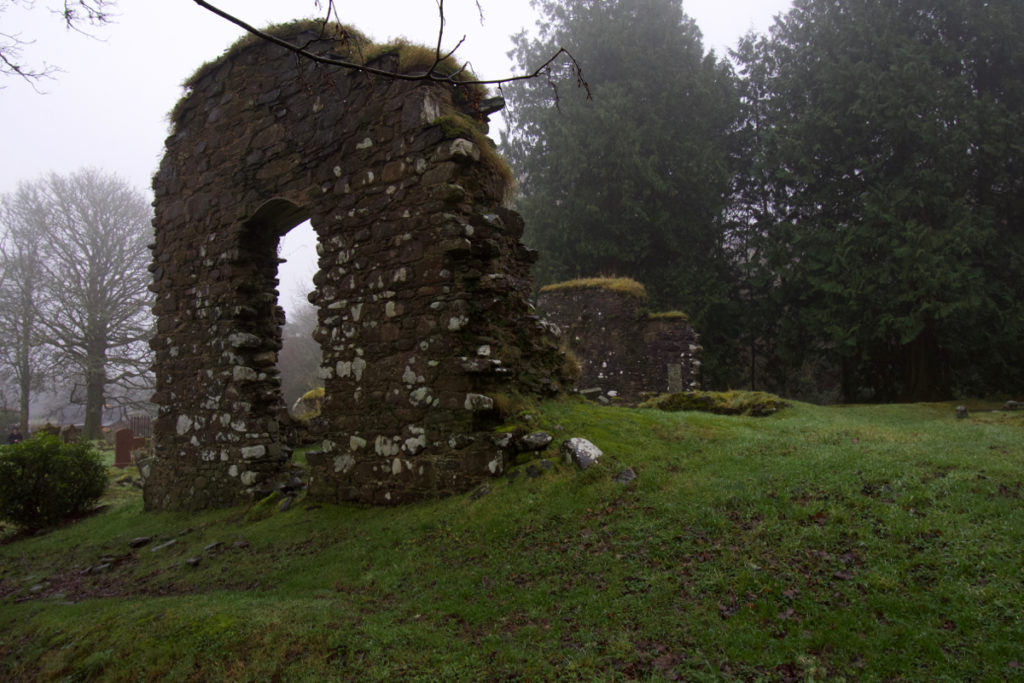
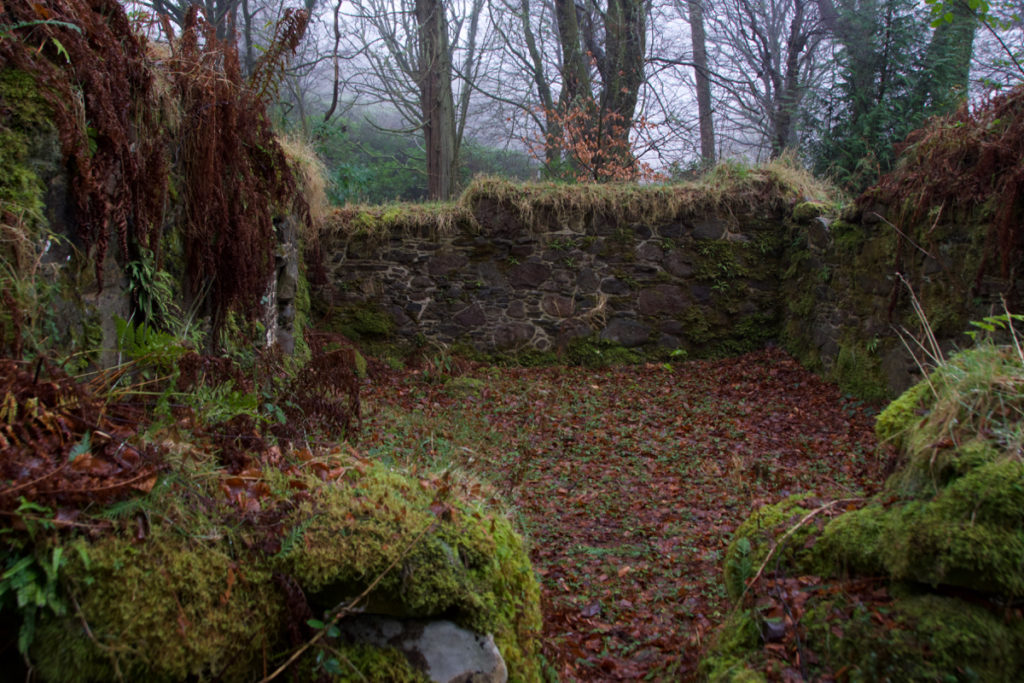
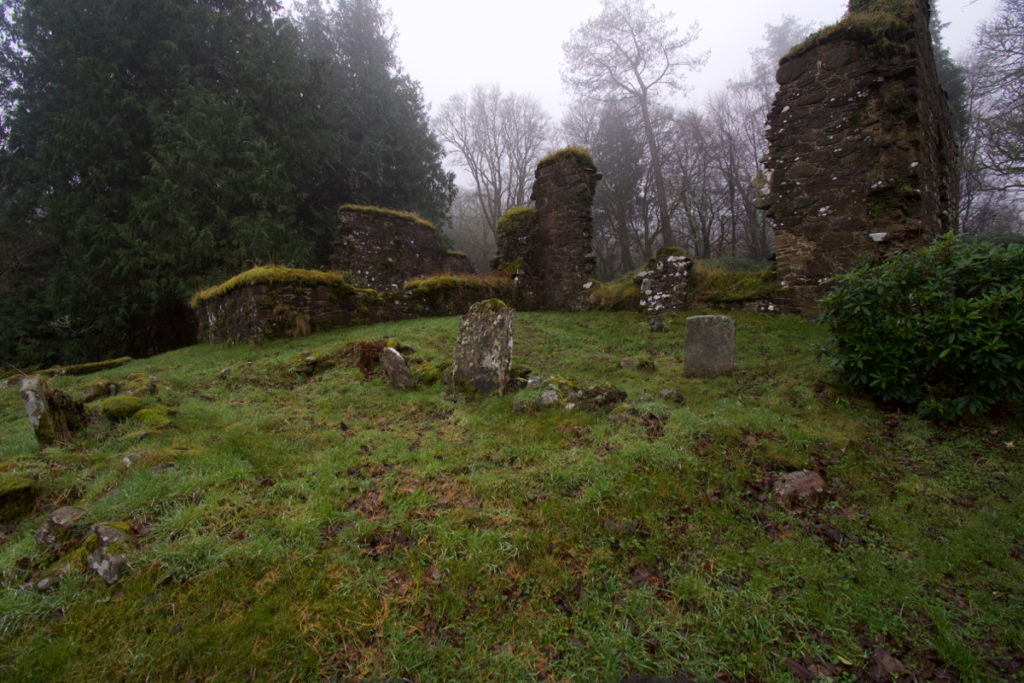
That’s not to say that Saddell was insignificant – far from it. There’s a connection here with one of Scotland’s most enigmatic warrior-heroes: Somerled of the Isles. It is believed that Somerled or his son instigated the abbey’s construction, and it may even be the place where he was finally laid to rest.
Who was Somerled?
The warrior Somairle or Somerled (literally, ‘summer-wanderer’, as so many of the Norsemen were) is thought to have come from a Norse-Gaelic family. He married Ragnhild, daughter of the Norse King of Man; in the mid-12th century, with his fleet of beautifully-built birlinns or galleys, he defied both the Scottish and Norwegian kings and rose to power, declaring himself Rí Innse Gall or King of the Isles, with a wide territory that stretched across the Hebrides and parts of mainland Argyll. Somerled’s descendants were the MacDonald Lords of the Isles, who ruled the west of Scotland until 1493, when their lands and titles were seized by James IV of Scotland.
There appears to be some debate about exactly when Saddell Abbey was established, but it is generally accepted that either Somerled or his son was the founder. Among 13th century manuscripts in the British Museum it is mentioned as ‘Saundell in Cantire circa 1163’, and ‘Sconedale MCLX (1160)’. These dates point to an act of foundation that would have taken place before the death of Somerled in 1164; but other sources suggest that Somerled’s son, Raghnall, was the founder, or even his grandson. “It is probable that the buildings were not completed, and the monks assembled, before Reginald’s [Raghnall’s] death in 1207, for it is not included in the list of Scottish abbeys in Gervase of Canterbury’s Mappa Mundi, written between 1205 and 1211.”
(Quotes from: ’A Chronology of the Abbey and Castle of Saddell, Kintyre’, by Andrew McKerral, pub. by the Society of Antiquaries of Scotland)
The monks were of a Cistercian order, and the abbey was a daughter house of Mellifont in the diocese of Armagh. Historic Environment Scotland says: “The community was probably small in numbers and the recorded endowments are not extensive. Most of the property held was in Kintyre, but the monastery also had possessions in Gigha, Knapdale, Carrick and Arran.”
‘Saddell’ is from the Norse words meaning ‘sandy dale’ or ‘sandy bay’.
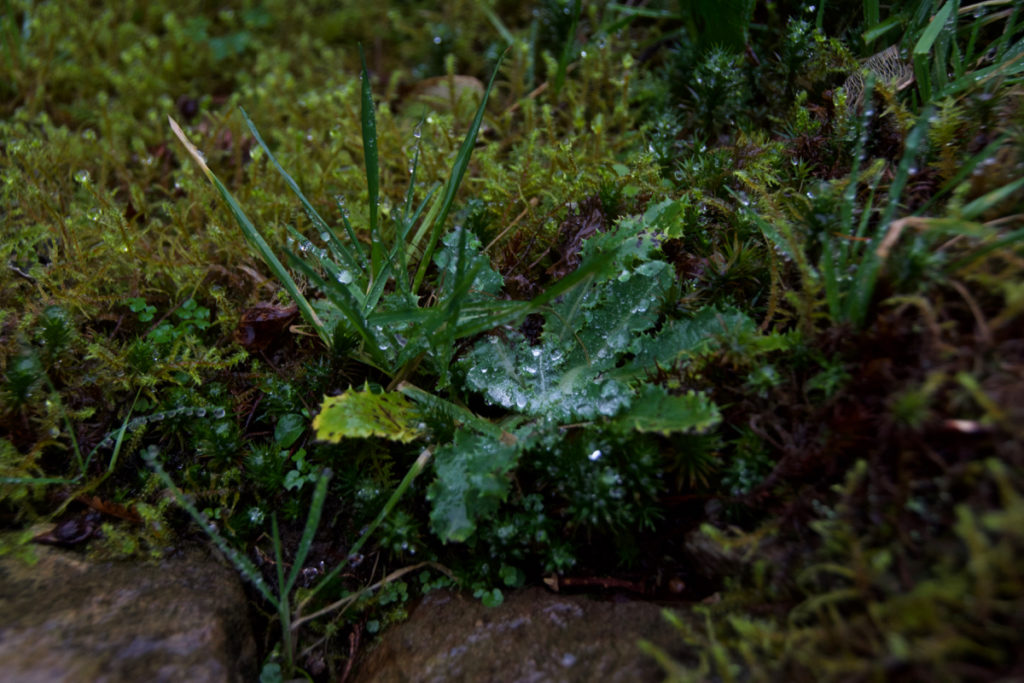 And was Somerled buried here, instead of on the island of Iona, as some historians have suggested? There is a distinct possibility, although no evidence has been found. Against this proposition is the likelihood that the abbey may not have been completed at the time of his death. But perhaps Somerled was re-interred at Saddell when it was finished: “If indeed Somerled’s remains were removed from their original place of burial – presumably by his son Ranald, but no less possibly by his grandson Donald – the most likely purpose in so doing would have been to confer prestige on the monastic foundation they had at long last brought to completion.” (‘Somerled and the Emergence of Gaelic Scotland’ by John Marsden)
And was Somerled buried here, instead of on the island of Iona, as some historians have suggested? There is a distinct possibility, although no evidence has been found. Against this proposition is the likelihood that the abbey may not have been completed at the time of his death. But perhaps Somerled was re-interred at Saddell when it was finished: “If indeed Somerled’s remains were removed from their original place of burial – presumably by his son Ranald, but no less possibly by his grandson Donald – the most likely purpose in so doing would have been to confer prestige on the monastic foundation they had at long last brought to completion.” (‘Somerled and the Emergence of Gaelic Scotland’ by John Marsden)
In 1470 is the last reference to be found of an abbot at Saddell, by which time the abbey “appears to have been in a state of dissolution.” (McKerrall). In 1507 James IV granted the abbey and its lands to David Hamilton, Bishop of Argyll. Using material from the ruins, Hamilton began constructing a new residence for himself – Saddell Castle, further down towards the shore.
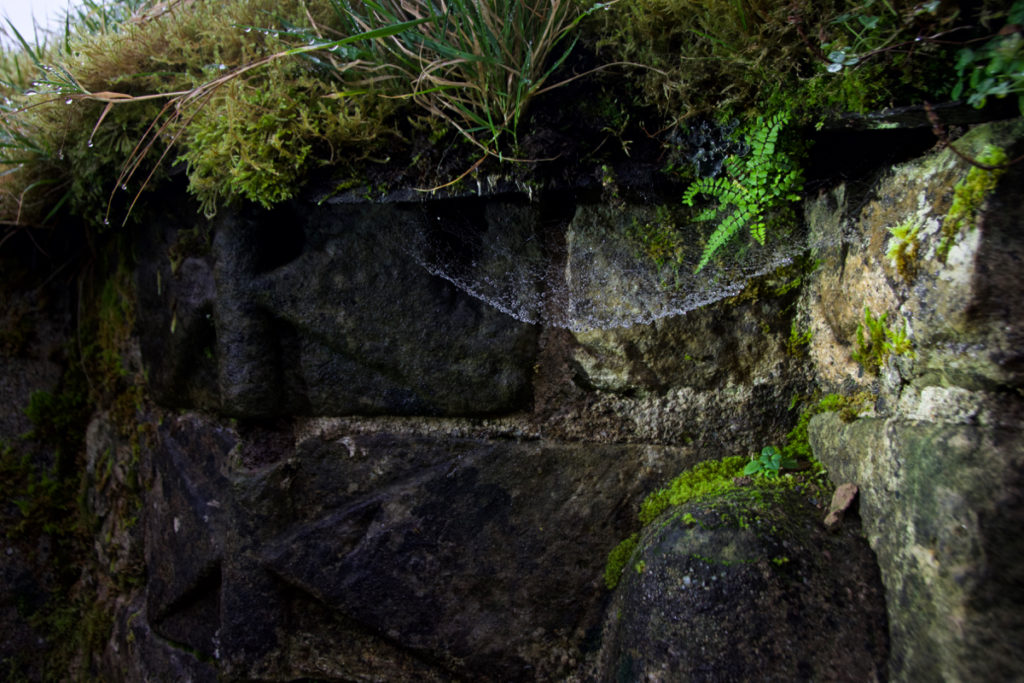 Colin and I wandered – or squelched – happily around the dripping ruins, peering at carvings in the old walls. Although it can be quite a sad exercise, I do like reading gravestones and trying to understand the lives and losses of families, especially because sometimes this is all that remains of a human story. Next to one of the church walls I stopped to read a stone with light grey lichen covering a nicely rounded script, and found myself staring at the name ‘MacKinlay’.
Colin and I wandered – or squelched – happily around the dripping ruins, peering at carvings in the old walls. Although it can be quite a sad exercise, I do like reading gravestones and trying to understand the lives and losses of families, especially because sometimes this is all that remains of a human story. Next to one of the church walls I stopped to read a stone with light grey lichen covering a nicely rounded script, and found myself staring at the name ‘MacKinlay’.
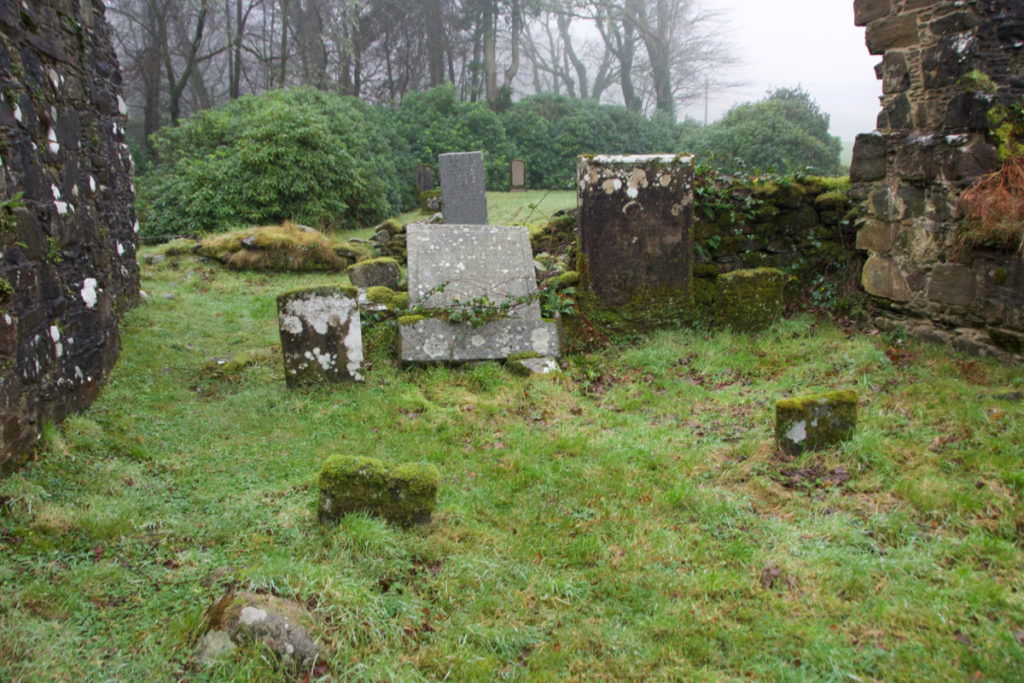 MacKinlay stones
MacKinlay stones
You might remember that I wrote about an old MacKinlay burial ground near Loch Lubnaig a few years ago, and out of this blog post came a wealth of friends and connections from all over the world. How strange, then, at the bottom of Kintyre, in another ancient burial site, to be looking at more MacKinlays! I have photographed the stones, which were grouped together as if in a family plot. If you’d like more information, I’ll be happy to supply it.
And there were other names too… John Shaw, a vintner from Carradale; Blackstock, Straughan, Galbraith, Blair, McCallum. These were just the ones I could read. Another stone, of a Campbell I think, must take the prize for the most elegantly moss-covered stone I’ve ever seen.
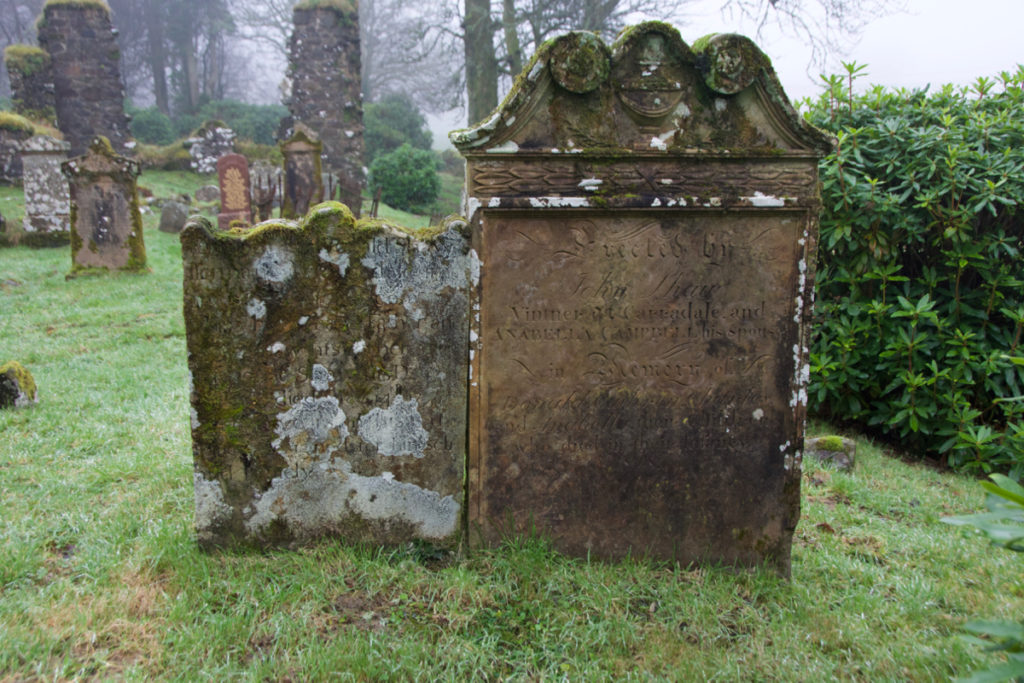
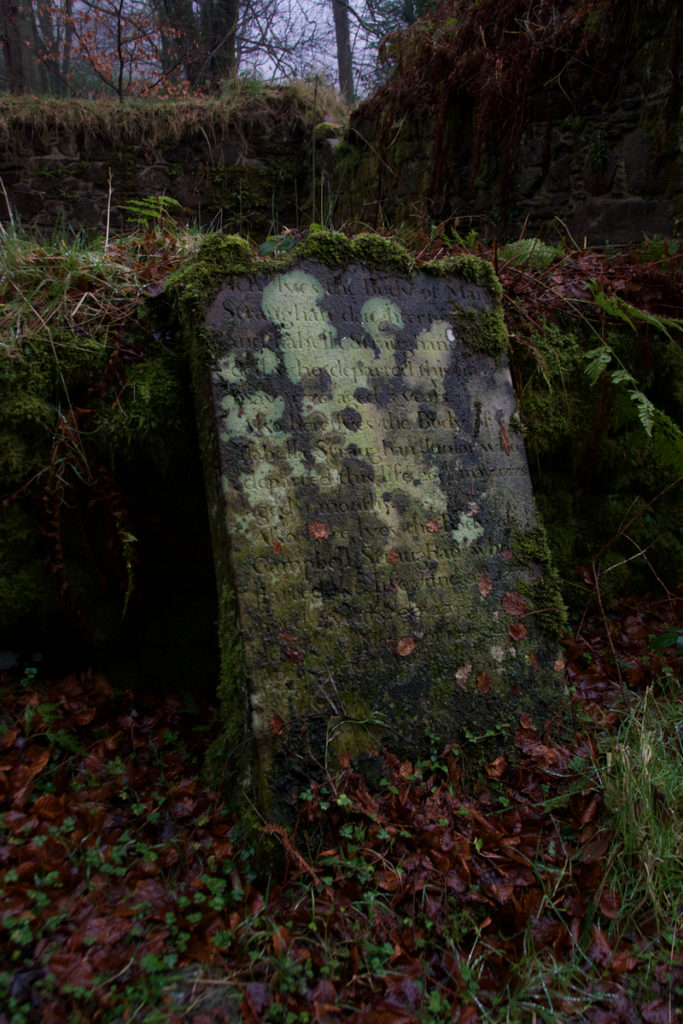
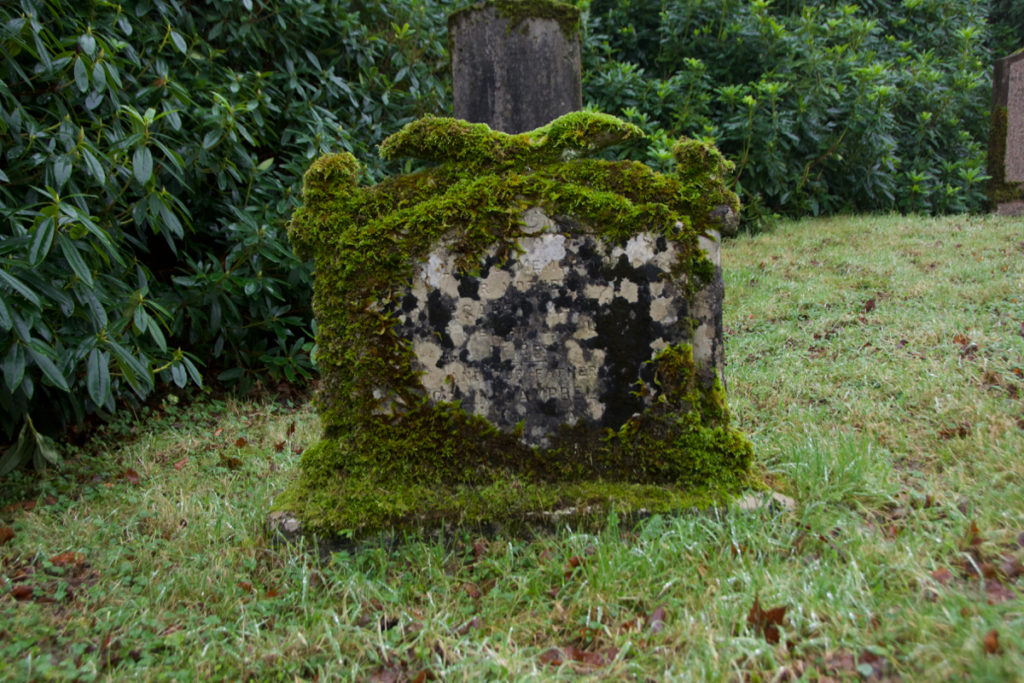
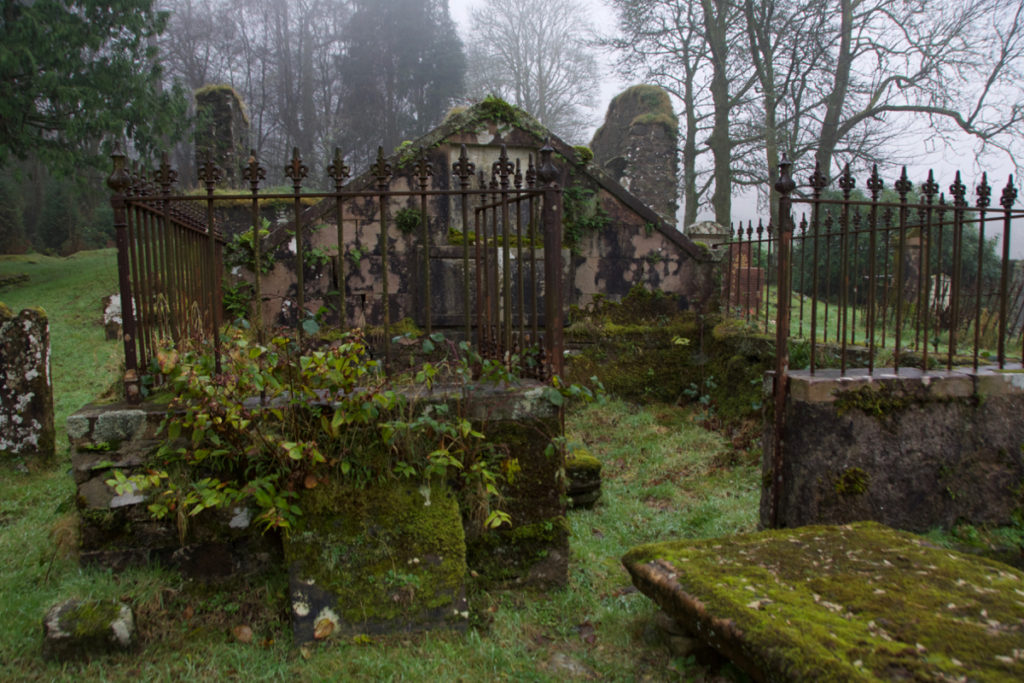 Above: The information board told us that the largest burial monument in the graveyard is for Colonel Donald Campbell of Glensaddell, dating from 1784.
Above: The information board told us that the largest burial monument in the graveyard is for Colonel Donald Campbell of Glensaddell, dating from 1784.
I’m quite glad I didn’t know this beforehand, but I came across one website which claims that the abbey ruins are haunted by “a huge black spectral hand”. On one occasion, on a particularly dark night, this hand is supposed to have pursued a local tailor all the way down the lane to Saddell Castle, where some small indentations on the left of the doorway are still known as the ‘devil’s handprint’. Worryingly, the story doesn’t reveal what became of the tailor. Logic forces me to ask how a hand can actually pursue anything, but the ethereal quality of the abbey ruins, combined with the long path down to the castle, gloomily overhung by tall trees, makes me shiver all the same.
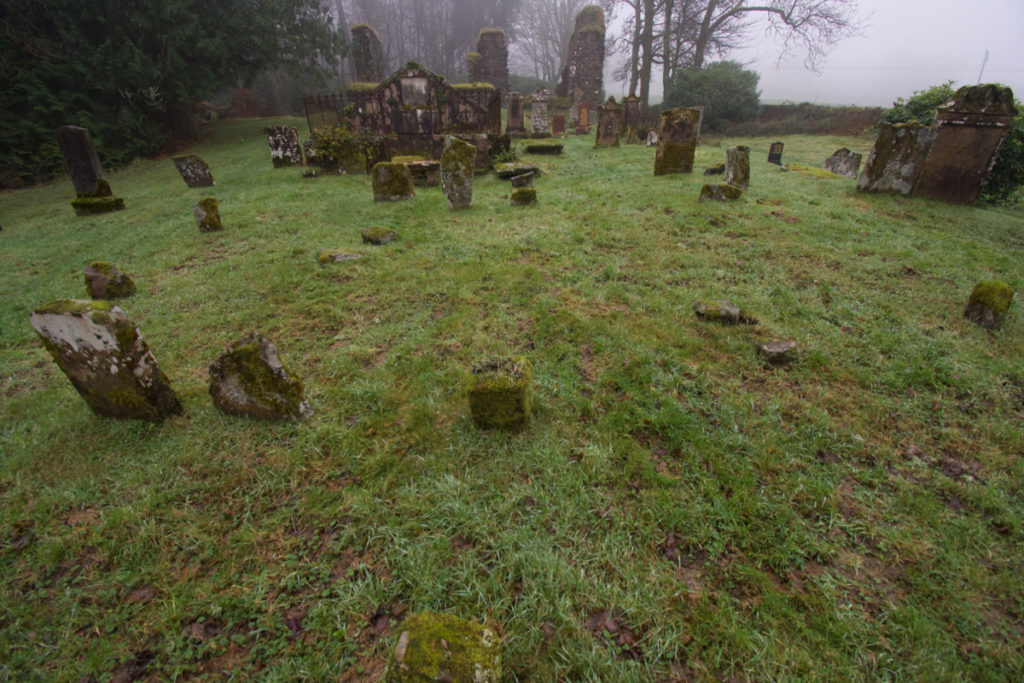
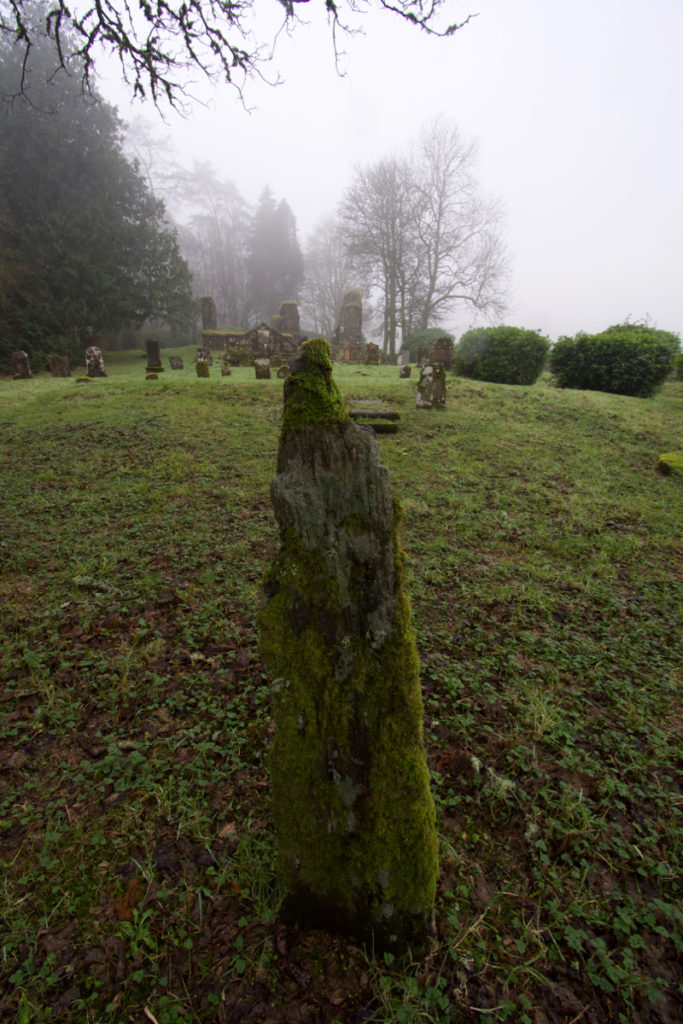 Something else intrigued me about the graveyard around the abbey. Towards the lower end are some stones that struck me as looking more like a stone circle, or at least an alignment of some sort. Although some were recognisable as headstones, others were irregular in size, shape and outline. Old gravestones do crack and split quite dramatically, but these ones had a look of something more ancient. They may just be especially old stones, placed in an arrangement of a family plot. I haven’t yet found any suggestion of a more ancient site here, but I’ll keep looking.
Something else intrigued me about the graveyard around the abbey. Towards the lower end are some stones that struck me as looking more like a stone circle, or at least an alignment of some sort. Although some were recognisable as headstones, others were irregular in size, shape and outline. Old gravestones do crack and split quite dramatically, but these ones had a look of something more ancient. They may just be especially old stones, placed in an arrangement of a family plot. I haven’t yet found any suggestion of a more ancient site here, but I’ll keep looking.
From the abbey, we took a stroll down to Saddell Castle, former residence of the Bishop of Argyll. Blissfully ignorant that we should be checking behind us for signs of an approaching spectral hand, we lingered a while in the woods on either side of the path, photographing the first emerging snowdrops – what a joy to see.
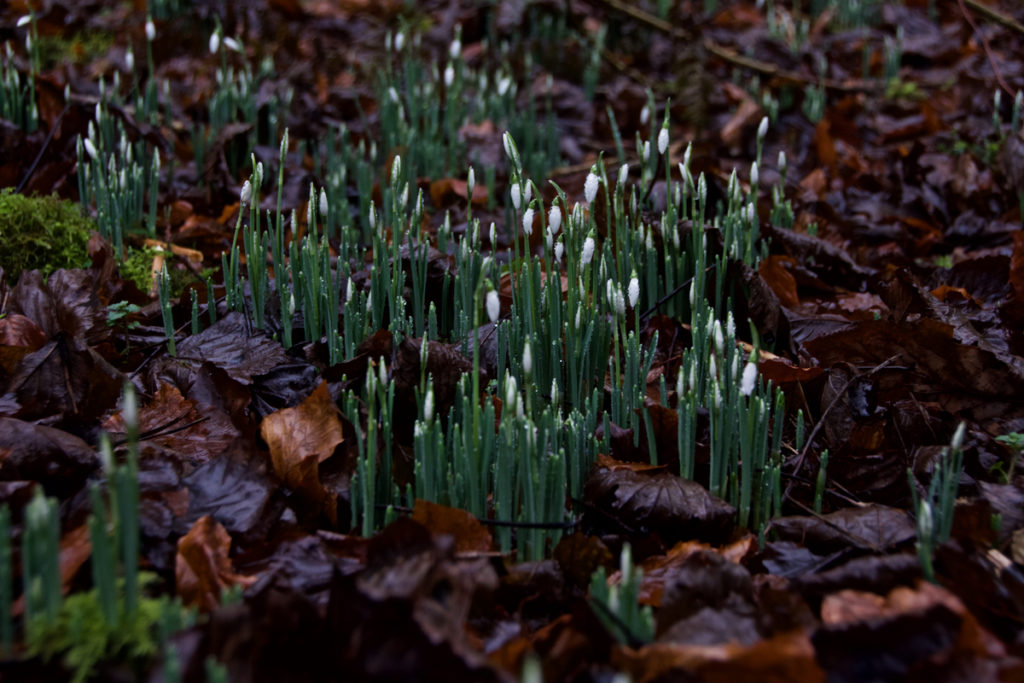
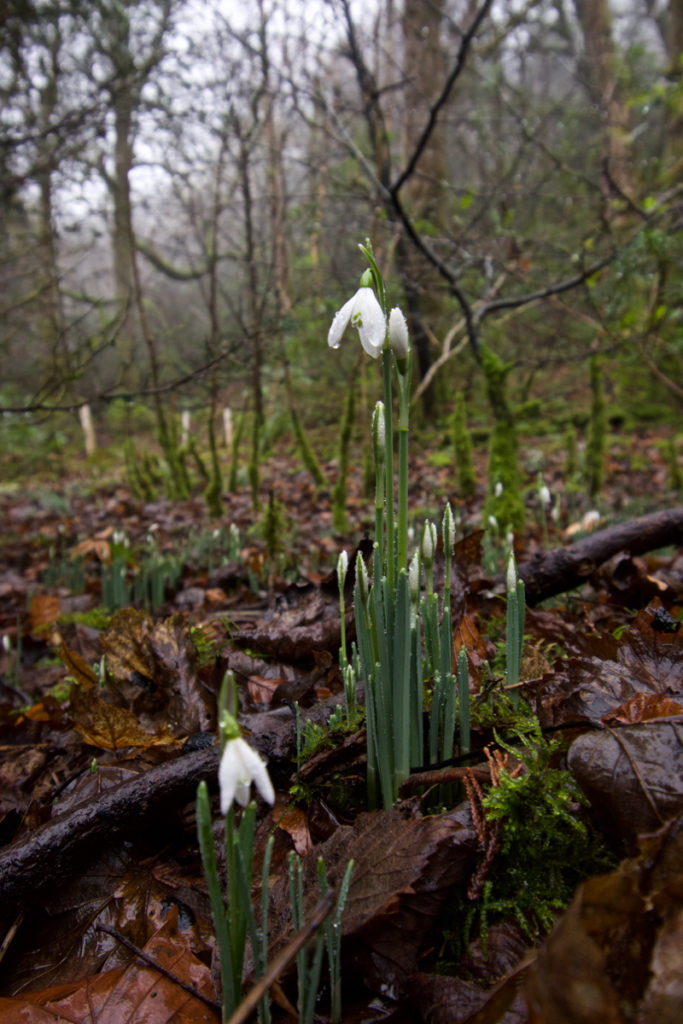
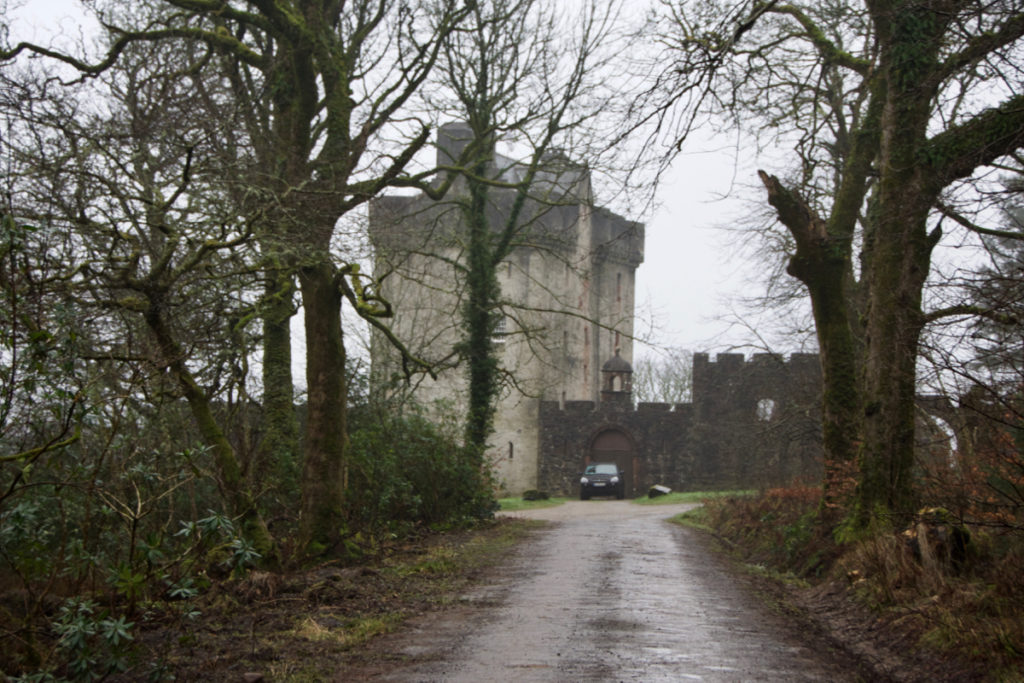
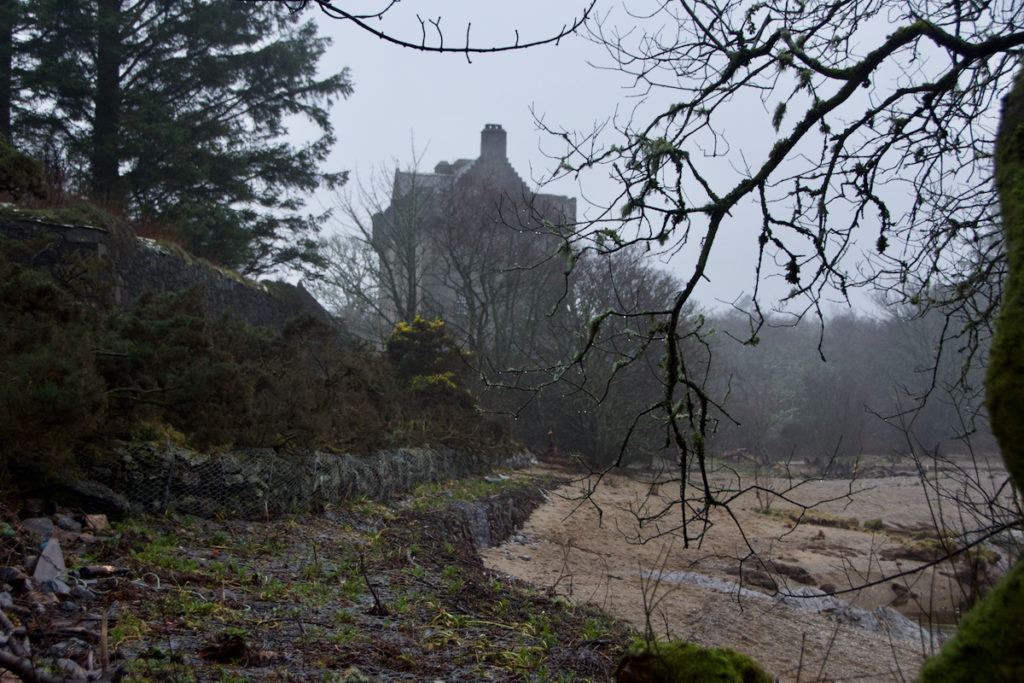
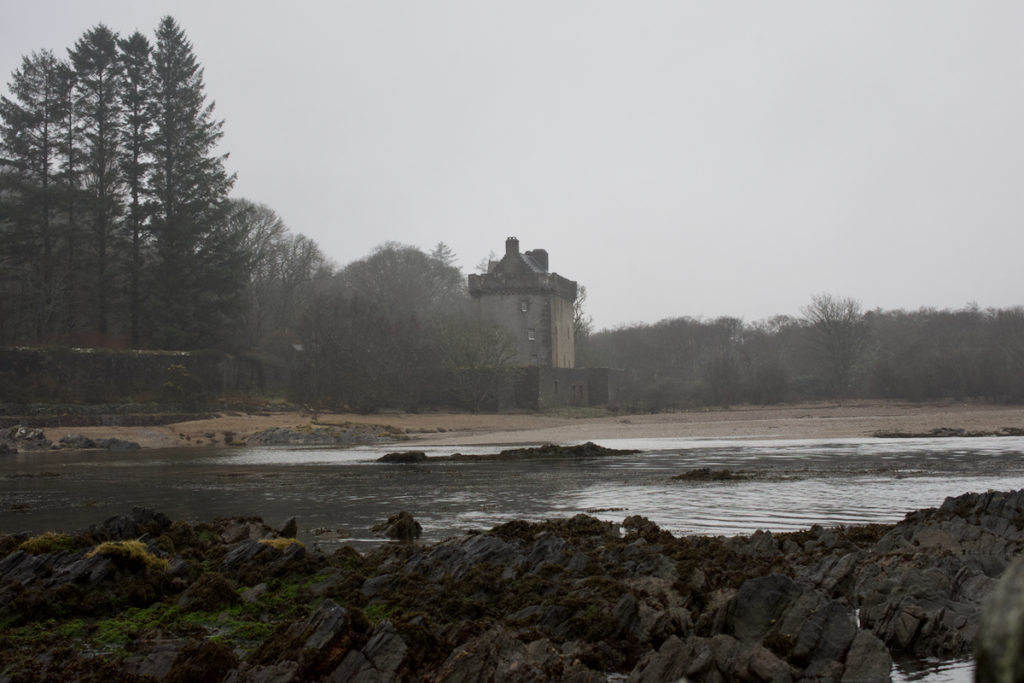 Saddell Castle presented a deliciously romantic appearance. A four-storey oblong tower house dating from 1507, it has been beautifully restored, and is in the care of the Landmark Trust. There appeared to be occupants, so we tried not to stare too hard at the windows. It is reputed to be haunted, too: its ghostly inhabitants include a white lady and a monk. Some sources suggest that these are the spirits of people laid to rest in the abbey graveyard, who were disturbed when stone was robbed from the site during the castle’s construction. It stands so close to the shore that the sea must come right up to the curtain wall at high tide.
Saddell Castle presented a deliciously romantic appearance. A four-storey oblong tower house dating from 1507, it has been beautifully restored, and is in the care of the Landmark Trust. There appeared to be occupants, so we tried not to stare too hard at the windows. It is reputed to be haunted, too: its ghostly inhabitants include a white lady and a monk. Some sources suggest that these are the spirits of people laid to rest in the abbey graveyard, who were disturbed when stone was robbed from the site during the castle’s construction. It stands so close to the shore that the sea must come right up to the curtain wall at high tide.
Our coats, boots, and cameras were dripping by the time we got back to the car, but it was an exhilarating little journey of discovery, despite – or perhaps because of – the weather. Our drive back was slightly quicker, because we went down to Campbeltown and then back up the west coast on the main road; I say ‘main’ road with some hesitation because a cow was sauntering down the middle of it, in the opposite direction, somewhere around Westport.
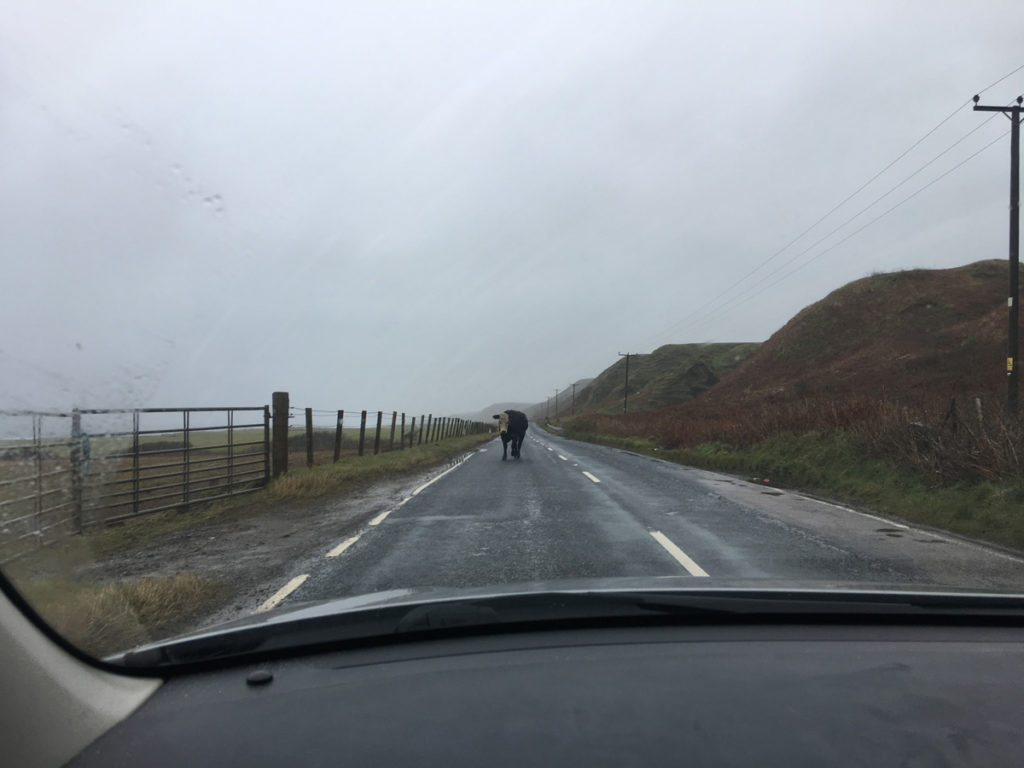
Sources and reference:
- Historic Environment Scotland: Saddell Abbey
- Historic Environment Scotland: Saddell Castle
- Canmore database
- “A Chronology of the Abbey and Castle of Saddell, Kintyre” by Andrew McKerral, The Society of Antiquaries of Scotland, 1951-52.
- ‘Somerled and the Emergence of Gaelic Scotland’ by John Marsden
- ‘The History of Scotland’ by Neil Oliver
- ‘Saddell Castle’ by Rev. James Webb
- Saddell Castle – Landmark Trust
“Far have I travelled, and much have I seen…” ‘Mull of Kintyre‘ was an incredibly popular release in 1977 by Paul McCartney and Wings. In the video, the pipers are actually marching on Saddell beach.
Photos copyright © Jo & Colin Woolf

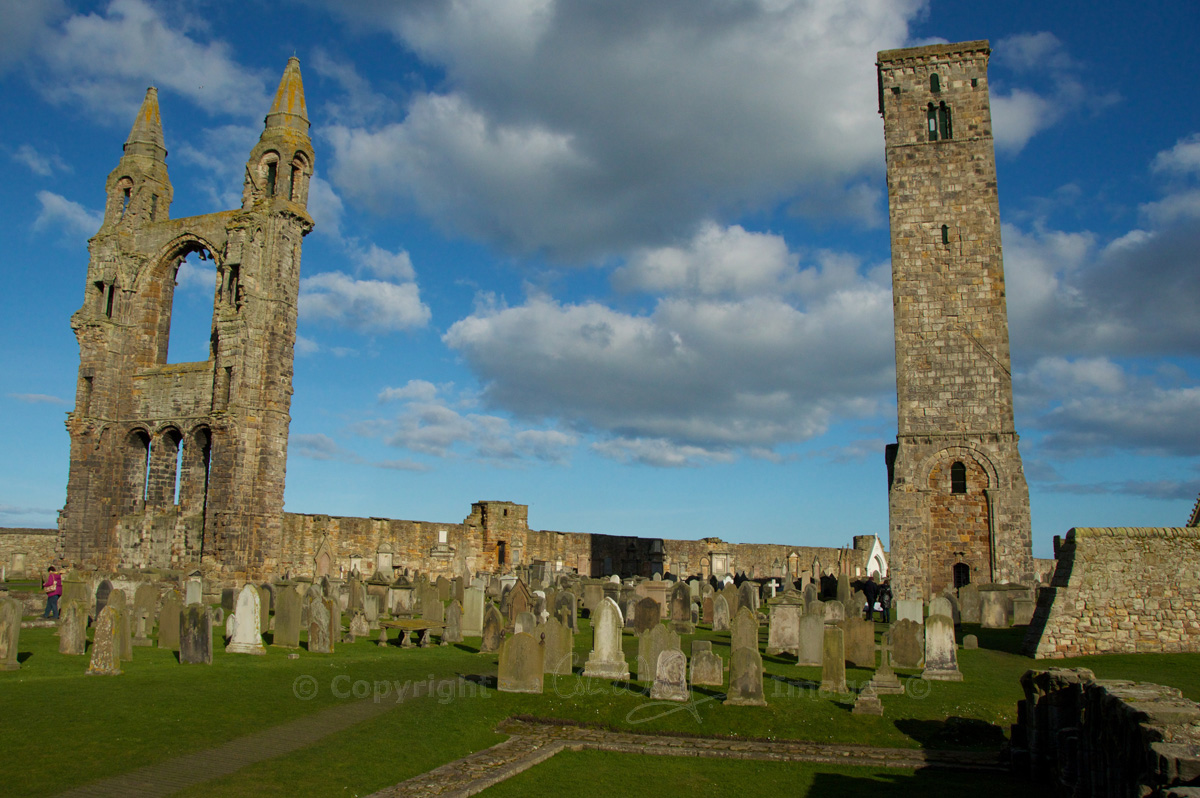
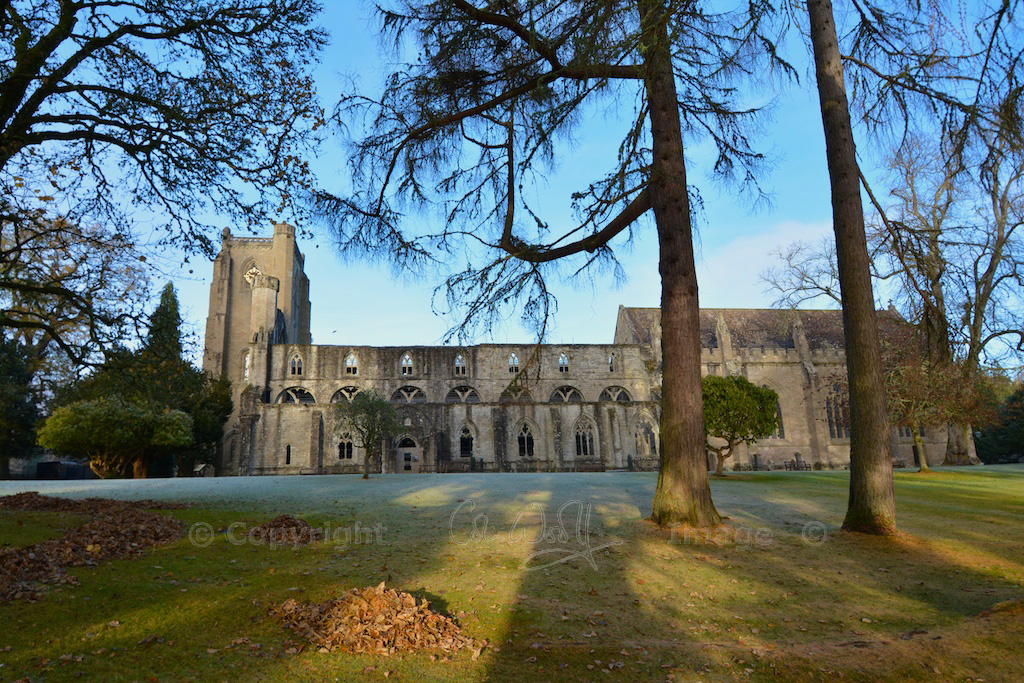
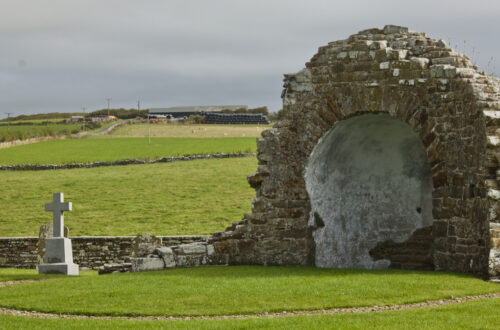
34 Comments
Cathy Bauer
Hi Jo, I love your blog. I am now living in Australia but my heart got left behind in Scotland and any information of my Spiritual home is received gladly. You may remember we met at a Dowsing workshop and I just wondered if you had dowsed the stones to see if that would provide some answers. It might be interesting. Regards, Cathy Bauer
Jo Woolf
Thank you very much, Cathy! Yes, I do remember, and so you’re in Australia now! I hope all is going well for you. Agh, if only I remembered my dowsing rods on these occasions! I have made a mental note to do more dowsing this coming year, especially around the Kilmartin sites. If I do, I will certainly report it on here! Hope you are having fun dowsing too. Grahame keeps offering more interesting courses and I am often tempted! Best wishes, Jo
edith Douglas
The photos are beautiful, and the text made me laugh twice. O the snowdrops! We have had several John Shaws in my family over the generations (and I am sure there are and have been many, many more in the world). Our current John Shaw is a recently married computer technician who lives in Chilliwack, B. C., and how very odd now to know about one buried near Sandell Abbey, a vintner from Carradale. Thanks.
Jo Woolf
Thank you very much Edith! 😀 That’s good to know. Yes, the snowdrops were such a welcome sight! Possibly the earliest we’ve seen them. That’s interesting about John Shaw! Maybe they are connected!
Greig
Lovely photographs. Hope to visit there this summer and see the house Paul was at while filming Mull of Kintyre
Jo Woolf
Thank you, Greig! I hope that you have fun exploring Kintyre. It’s been a while since we were down there, but it doesn’t seem to have changed much. Hope you have better weather, though! 😀
Scott K Marshall
Happy New Year Jo, your blog post depths – always blow me away – especially if the WordPress algorithm has omitted from my feed – anyway considering what a poor hand you were dealt with by the weather – it’s another cracking blog. Definitely worth a trip again in better conditions.
Jo Woolf
Happy New Year to you too, Scott! Thank you very much – that’s very kind. Yes, I’m sure it would look so different in better weather!! Maybe not so atmospheric, though, haha! 😀
Linda
I love your blog and fascinating photos. They capture the dreich weather and are very atmospheric. Thank you for documenting this wonderful part of my homeland.
Jo Woolf
That’s lovely to know, Linda, thank you! I knew when I was taking the photos that they’d be atmospheric! 🙂 You are most welcome, and I’m glad you enjoy these virtual visits to your homeland.
Thomas
Thanks so much! I’ve been learning to sail with Sport Scotland on Isle of Cumbrae, they have 2 large yachts, one is called Somerled, I smiled when I realised the name for the first time, we spent the night at Carradale on one or our sailing lessons. Find history fascinating! Thank you
Jo Woolf
That’s wonderful that you sailed on a yacht called Somerled, and came into Carradale! Sounds really fun. Really glad you enjoyed the post, and thank you! Yes, the history of this place is just amazing.
montucky
Fascinating post! I can picture wandering around there and I know I would enjoy that, with my head spinning because of the depth of the history there.
Jo Woolf
Thank you! Yes, what a fascinating place! I am sure you would enjoy it too, and you’d have loved all the lichens and mosses!
Linda
I’ve been following your posts for some years and have them all saved for future reference!
This one took me back to walking the Kintyre Way and visiting Saddell Abbey then. I then took my husband (also Colin!) another time. Delighted to see the snowdrops appearing!
We are staying at our second home in Glenborrodale which we have had for over 45yrs and never tire of visiting but for my birthday tomorrow we will travel home to Bridge of Allan, still a fabulous journey! Looking forward to more of your travels!
Jo Woolf
How lovely, Linda – you must have had a fabulous time walking the Kintyre Way. Is that Glenborrodale in Ardnamurchan? Another amazing place. Yes, it was so nice to see the snowdrops at Saddell! Spring isn’t far away. I hope you have a lovely day tomorrow, and wishing you a Happy Birthday! Thank you for your kind comments.
Cornell
The grass is so green for this period of the year.
And there are snowdrops! Again, so early but yes, a joy to see. .
Jo Woolf
Yes, very green! And the mosses too. We’ve had a damp, mild winter so far. Yes, the snowdrops were beautiful! A real promise of spring.
davidoakesimages
Happy New Year Jo…..Now you really must stop these temptations….That list of places to visit just keeps getting longer and longer. The upside is that I get to enjoy them from the warmth of my study with a cup of coffee, not as exciting as the weather you were blessed with but from my perspective rather enjoyable.
Jo Woolf
Thank you, David, and to you! Glad you’re inspired to get the camera out! Quite demanding weather we’re having! But great for places such as this.
Moira Goodman
Wonderfully intriguing Blog Jo wonderfully written by you as usual. Loved the carved gravestones and some of the detail is so clear you would almost think they had been done recently. Really just wanted to take off for a visit when I read this so must try and visit someday. You live in a wonderful part of Scotland for exploring.
Jo Woolf
Thank you very much, Moira! I do hope you can get to visit Saddell someday. Yes, the gravestones held some surprises, didn’t they?! It would be worth spending more time trying to decipher the others too.
JennyOH
Please, never stop showing us yet more ruins and medieval carved gravestones! I enjoyed every one of these misty-moisty photos. Happy New Year and happy birthday!
Jo Woolf
Haha, thank you very much, Jenny and a Happy New Year to you too! Don’t worry, I think it would be impossible to stop! It’s such a pleasure and a surprise to find these places – you never know what else you’re going to discover. Really glad you enjoyed the pics!
shiningbearheart
Lovely!!!
Jo Woolf
Thank you! Glad you enjoyed it.
Glenda Hunter
Oh Jo what a magical place love all your pictures and stories love reading about your beautiful country’s history land of my ancestors thank you so much for bring Scotland to me ☺☺☺
Jo Woolf
You’re most welcome, Glenda, and I’m very glad to hear you enjoy reading about it so much! It certainly is a beautiful country – we’re very lucky to live here. Worth braving all the wind and rain for! 🙂 Thanks for your lovely comment.
Bob Hay
Hi Jo. Just saw your Saddell trip when looking again at the castle in the loch.
I thought I might have commented on Saddell at the time, asking if you’d wandered down to the stream that gurgles beneath the graveyard and seen the little Christian baptism font with the water literally coming out of solid rock. The locals call it the Wishing Well and you won’t taste more refreshing water anywhere. The day I visitedthe graveyard I noticed someone had put a little milk bottle with flowers in it on a wall and I have to admit I almost cried at the piety of it (and I’m a non believer!).
The aura in these old religious buildings goes right into my bones.
Jo Woolf
Hi Bob, no, we didn’t find the font but I wish we had! A good reason to go back. Maybe this is the original spring that attracted people to its healing energy before there were any thoughts of a Christian site. It is moving to find little tokens like you found, even in out of the way places where you think people never go. Reassuring that they’re still respected and loved.
Bob Hay
See this Jo.
https://www.megalithic.co.uk/article.php?sid=15487
Jo Woolf
Thanks Bob!
Cate Thonas
Hi – I had the privilege of stopping at Saddell Castle in January. It is certainly haunted but I will return after restoration
Jo Woolf
Crikey! You’re brave to come back, restoration or no!